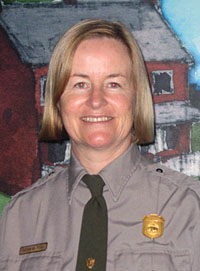Trail takes helm at Antietam Battlefield
 Monocacy National Battlefield Superintendent Susan Trail has been selected to serve in the same capacity at Antietam National Battlefield, succeeding former Superintendent John Howard, the National Park Service announced in November.
Monocacy National Battlefield Superintendent Susan Trail has been selected to serve in the same capacity at Antietam National Battlefield, succeeding former Superintendent John Howard, the National Park Service announced in November.
“With someone of Susan Trail’s experience, educational background and demonstrated keen interest in Civil War Battlefield preservation and protection, I can’t think of a more qualified and exemplary candidate for this job,” said NPS National Capital Region Director Steve Whitesell.
“Susan’s dedication and determination to succeed will not only assist the NPS, but help to best serve the American public’s interest, which is to see Antietam National Battlefield and its stories preserved and maintained for future generations.”
Trail will be returning to Antietam, a park where she was the assistant superintendent for five years, from 1997 to 2003. Trail also worked as cultural resource manager at the C&O Canal National Historical Park from 1992 to 1997 and as supervisory archaeologist at Harpers Ferry National Historical Park from 1989 to 1992. Trail brings with her six additional years as an NPS contractor working as an archaeologist on a variety of projects in the National Capital Region.
Center planned for Honey Springs
The Battle of Honey Springs, in Oklahoma, featured an overlooked aspect of the Civil War in the West: the use of American Indian troops who sided with the Confederacy. A Union force that included the 1st Kansas Colored Infantry drove a poorly supplied Indian deployment from the field, opening the way for Federal occupation of Fort Smith on the Oklahoma–Arkansas border and control of the Red River Valley.
Today, several public and private organizations—tapping financing from grants, local banks and federal stimulus funds—are teaming up to build a 5,000-square-foot visitor center and library on the 1,100-acre battlefield site, which is owned by the Oklahoma Historical Society. The Friends of Honey Springs will lease the land from the historical society. The center will offer educational exhibits about the 9,000 soldiers who fought in the battle, as well as serving as a library and a community center for the residents of Rentiesville, said Ryan McMullen, state director of USDA Rural Development.
The National Park Service calculates that the new center will attract 150,000 people annually. It’s expected to be open by July 2013, in time for the 150th anniversary of the battle.
Recovered flag returned to New Orleans
At least 11 Confederate soldiers had been killed or wounded while carrying the colors of the 14th Louisiana Infantry when color bearer Frederick Sontag was captured with it at Gettysburg. Rather than surrender the flag, he hid it under his clothing until he was released. After the war, it draped the coffin of Confederate President Jefferson Davis and was carried at veteran reunions until, tattered and fragile, it was eventually donated to the Confederate Memorial Hall Museum in New Orleans by the 14th’s commanding officer, Colonel David Zable, and the Army of Northern Virginia Association.
And there it remained—until the mid-1980s, when it was apparently stolen by a now-deceased museum volunteer. Acting on a tip last fall, the FBI’s National Art Crime Team recovered the flag from a Caroline County, Va., collector who had purchased it without realizing it was stolen. Once he learned about the crime, he immediately relinquished the flag. Representatives of Memorial Hall traveled to Richmond to retrieve the flag in a brief ceremony at the Museum of the Confederacy, then brought it back home to New Orleans.
The 14th Louisiana was composed largely of Polish immigrants living in New Orleans, and saw action with the Army of Northern Virginia in some of the deadliest battles in the Eastern Theater—including Second Bull Run, Antietam, Chancellorsville and Gettysburg.




